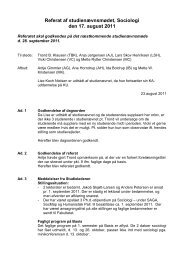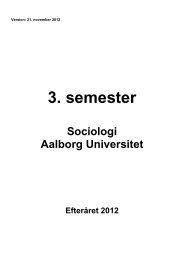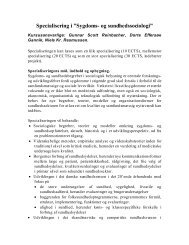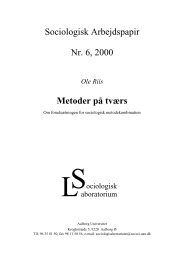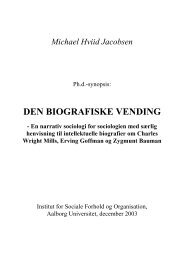Utopianism in the Work of Zygmunt Bauman - Sociologi - Aalborg ...
Utopianism in the Work of Zygmunt Bauman - Sociologi - Aalborg ...
Utopianism in the Work of Zygmunt Bauman - Sociologi - Aalborg ...
Create successful ePaper yourself
Turn your PDF publications into a flip-book with our unique Google optimized e-Paper software.
nity much to <strong>the</strong>ir own misfortune and to <strong>the</strong> annoyance <strong>of</strong> <strong>the</strong> technicians <strong>of</strong><br />
modernity, <strong>the</strong> state builders and economy planners <strong>of</strong> Keynesian consensus,<br />
for whom a perfect and stable order could and should be created for <strong>the</strong> sake <strong>of</strong><br />
<strong>the</strong> present and future <strong>of</strong> humank<strong>in</strong>d (<strong>Bauman</strong> 2002b). They were by history, as<br />
it were, proved to be blatantly wrong. As Marx made clear <strong>in</strong> The Eighteenth<br />
Brumaire <strong>of</strong> Louis Bonaparte, those who are ignorant or negligent <strong>of</strong> history<br />
may be condemned to repeat it and our collective recollection about what mod-<br />
ernist utopias could lead to is and ought <strong>in</strong> <strong>Bauman</strong>’s understand<strong>in</strong>g to be a<br />
bulwark aga<strong>in</strong>st repeat<strong>in</strong>g <strong>the</strong>m.<br />
In <strong>the</strong> liquefied postmodernity, after <strong>the</strong> demise <strong>of</strong> <strong>the</strong> modernist project as<br />
well as <strong>the</strong> dissolution <strong>of</strong> <strong>the</strong> polarised world-picture <strong>of</strong> two power blocs di-<br />
vided <strong>in</strong> true modernist fashion by a solid ‘iron curta<strong>in</strong>’, utopias have not, how-<br />
ever, vanished entirely but have taken on ever new mean<strong>in</strong>gs and versions more<br />
suitable for a ‘new global disorder’, <strong>the</strong> words used by Kenneth Jowitt to char-<br />
acterise our contemporary condition. The idea <strong>of</strong> a utopian convergence <strong>of</strong> <strong>the</strong><br />
mass utopian or ideological values <strong>of</strong> East and West, which many sociologists<br />
and political scientists found so appeal<strong>in</strong>g and endear<strong>in</strong>g throughout <strong>the</strong> polar-<br />
ised post-World War II period (cf. Buck-Morss 2000), was erected as an unsta-<br />
ble house <strong>of</strong> cards but, as <strong>Bauman</strong> noted, <strong>the</strong>se cards have now been reshuffled<br />
after <strong>the</strong> end <strong>of</strong> <strong>the</strong> ‘Great Schism’ that for almost half a century polarised <strong>the</strong><br />
world. Today we are <strong>in</strong>stead witness<strong>in</strong>g a new world disorder where <strong>the</strong> arrow-<br />
head <strong>of</strong> progress does no longer po<strong>in</strong>t <strong>in</strong> one frozen unil<strong>in</strong>ear direction but like<br />
<strong>the</strong> small p<strong>in</strong> <strong>in</strong> a compass is constantly frustrated by <strong>the</strong> uproot<strong>in</strong>g and chaos<br />
<strong>of</strong> <strong>the</strong> surround<strong>in</strong>g environment. Thus, <strong>the</strong> future <strong>of</strong> utopia as a way <strong>of</strong> imag<strong>in</strong>-<br />
<strong>in</strong>g a different world looks bleaker than ever before if understood <strong>in</strong> traditional<br />
modernist terms and brighter if seen through <strong>Bauman</strong>’s at times optimistic, at<br />
o<strong>the</strong>r times more pessimistic postmodern optics. So where do we go from here?<br />
23



